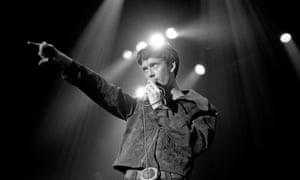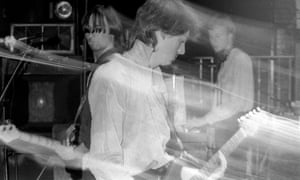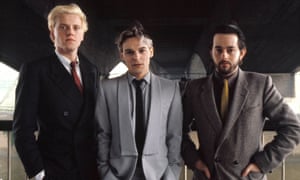
In the late 70s, the city’s bands set out to create the sound of the future – while trying to avoid getting beaten up. Jarvis Cocker and other leading lights recall a revolutionary scene

‘Sheffield in 1977 had a slight feeling of being the city of the future,” recalls Jarvis Cocker. “I didn’t realise that it was all going to go to shit. It was Sheffield before the fall.”
That pre-fall year is the starting point for a new box set: Dreams to Fill the Vacuum: The Sound of Sheffield 1977-1988. Familiar names appear – Pulp, Heaven 17, the Human League, ABC – but they are joined by a wealth of other acts, such as I’m So Hollow, Stunt Kites, They Must Be Russians and Surface Mutants, spanning punk, post-punk, indie and electronic with that droll outsider energy particular to South Yorkshire.

Sign up for the Sleeve Notes email: music news, bold reviews and unexpected extras
Read more
In 1977, Paul Bower was producing a local fanzine, Gun Rubber, and playing in the Buzzcocks-indebted 2.3. Like Cocker, he recalls the late-70s as being a time of optimism and flux. “There’s this myth of northern miserablism, that everything was shut down and shit,” he says. “But it wasn’t – that came later. It was a really interesting, bustling and creative time.”
Sheffield had plenty of dirt-cheap “little mester” workshops, once used by master craftsmen working in the city’s cutlery industry, and these provided room for bands to move in and experiment. Bower’s band 2.3 shared a space with the Future, an early incarnation of the Human League that featured Martyn Ware and Ian Craig Marsh along with Adi Newton before he formed Clock DVA. “We were enamoured with the New York scene,” says Ware. “In our own little way we were imitating the Exploding Plastic Inevitable.” Bower describes it as: “Andy Warhol’s Factory in the land of Bobby Knutt.”
The pioneering industrial and electronic outfit Cabaret Voltaire had been active since 1973. “They were the godfathers of Sheffield’s new music,” says Simon Hinkler, who played in bands such as TV Product and Artery, as well as producing early Pulp. “You can’t overstate how important they were.” Ware echoes this. “They were our mentors,” he recalls. “Their methodology and lifestyle was something we aspired to. Not so much musically, but as a template for doing your own thing.”

Cabaret Voltaire took on Western Works, another old cutlery factory, as their studio. While Ware looked to New York for inspiration, Cabaret Voltaire’s Richard H Kirk was more interested in Germany. “Kraftwerk and Can had their own spaces,” Kirk says. “We thought that was the perfect model. You could be there 24/7 without having to worry about the clock or some idiot engineer not knowing what to do with you.”Advertisement

“The environmental influences were very strong,” says Jane Antcliff-Wilson of I’m So Hollow. “Industrial and austere – steeped in working-class history. Imagination and vision were left to run wild in this bleak landscape.”
By 1978, an explosive flurry of music was coming out of the city. “Punk was year zero and Sheffield really took that to heart,” says Cocker. “They said: ‘Right, we’ll invent the music of the future.’ The Cabs and the Human League really did do that.” It was enough for people to move to the city because of it. Jake Harries of the industrial punk-funk band Chakk was one. “This music didn’t sound like it came from anywhere else,” he recalls. “There was an otherness to it. Sheffield sounded like the place to be – it was electronic, strange and inspiring.”
Not everyone warmed to peculiar new sonic explorations such as Cabaret Voltaire’s heavily deconstructed cover of the Beatles’ She Loves You. “This guy stormed out and physically grabbed me,” says Bower. “He’s screaming: ‘You’ve got to stop them. It’s sacrilege, they are destroying the Beatles.’ I said: ‘Yeah, that’s the point.’” Kirk thrived on the friction. “We went out of our way to pour petrol on the fire,” he says. “We knew people had never heard anything like what we were doing. It was meant to be confrontational.”
The throbbing intensity of Artery’s live shows were as terrifying to some as they were thrilling to others; Clock DVA got banned from venues after their first gig; during one gig, I’m So Hollow were thrown off stage after just two songs. The debut Human League show went down surprisingly well, even if their new singer hadn’t mastered his role yet. “Midway through the gig, Phil Oakey walks off stage, straight through the audience with his high heels on,” remembers Bower. “Comes up to the sound desk and says: ‘How’s it going?’ I said: ‘Fine, Phil, but it’s traditional for the singer to stay on stage during the gig.’”
Because of the conflict that would arise at shows, the Human League began performing with a Perspex shield around them. “Paul Morley wrote it was some extemporisation around alienation in contemporary society,” recalls Ware. “No, it was to stop skinheads gobbing on the synthesisers.”

Things got bleaker in the 1980s under Margaret Thatcher, even if some of the music got shinier and major-label attention followed. After the Human League’s 1981 album, Dare, made the revamped band world famous, major labels flocked to the city “signing groups in a bid to cash in on the scene”, says Newton. “We [Clock DVA] signed with Polydor but I consider this a low point, because innovation became secondary to commerciality.”
While pop stardom visited many, it seemed to evade one person. “The 1981 John Peel session Pulp did convinced me that I was going to be a teen star,” says Cocker. “But the 80s were depressing. The city was falling apart and our first album sold virtually nothing. I was crestfallen.” Violence was also an inescapable part of going out during this period. “It was like Pac-Man,” says Cocker. “You had to pick your route and avoid the beer monsters. Violence, or the threat of it, was a constant thing.” One night he had a pint glass land on his head; on another he was beaten up for wearing a patent leather mac. “I put two fingers up at them thinking my bus was about to leave, but it wasn’t, so they just got on it and smacked me.”
However, when the city was in sharp decline and the musical buzz of the early 80s was wearing off, Chakk did something crucial: “We signed with MCA and had them agree that we could build a recording studio out of our advance,” says Harries. FON Studio (named after a piece of local graffiti that read Fuck Off Nazis) was the result. Located in an old karate studio above a metal works, countless bands from across the UK recorded there. Richard Hawley’s teenage group Treebound Story was one. Rob Gordon, who would later co-found Warp records, found himself producing indie bands there in 1986 via a Youth Training Scheme. “It was obvious he was a genius,” recalls Hawley. “We were just kids but he made us sound amazing. He even tolerated us dropping acid, taking all our clothes off, playing the bongos and making a racket.”Advertisement

“It was a brave thing to do,” Cocker says of FON. “Sheffield was not going anywhere and it showed solidarity. They could have just taken the money and scarpered.” It was a combination of pride and practicality, according to Harries. “We thought it was crazy Sheffield didn’t have a large recording studio considering how much great music it produced. Plus, the country was divided at the height of Thatcherism. We wanted to bring some money from London to where we lived.”

FacebookTwitterPinterest Jarvis Cocker in 1991. Pulp formed in 1978 but had to wait till the early 90s before tasting success. Photograph: Martyn Goodacre/Getty Images
Over at Western Works, Cabaret Voltaire’s new neighbour was a bagpipe-playing Scotsman who was building and selling nuclear fallout shelters. “There was a rising sense of fear,” recalls Kirk of the time, one no doubt intensified for the people of South Yorkshire, given it was the location for the harrowing 1984 nuclear apocalypse TV drama Threads.
Even as the socio-political climate grew gloomier, that original spark of autonomy and ambition remained alight, says Hawley. “Even with all the shit going on from those horrible fuckers, a lot of magical stuff happened. Beauty came out of some very difficult situations.” Ware links this mentality to the city’s history. “There is pride in craft in Sheffield that runs through everything – from cutlery to engineering. It’s in our blood.”
Not all bands could contain their steam. “Artery had an intensity that was up there with Joy Division,” says Cocker. “But they didn’t have a Factory Records or a Tony Wilson. They got stuck in Sheffield, got frustrated, got off their heads, and lost it.” 2.3 had a single out on Fast Product before the Human League or Gang of Four, but collapsed. “We were like the Commitments but worse,” Bower says, likening the group to the dysfunctional Irish band from Roddy Doyle’s novel. “By 1979, it was like: ‘Screw it.’”
But others did make it, of course. The days of Cocker and co dodging pint glasses have been replaced by city-wide adulation, an irony not lost on them. “One day, some people were chasing me and Jarv down the street to get our autographs,” Hawley says. “Jarvis turned to me and said: ‘It’s not that long ago since the same people were chasing us down the road trying to kill us.’”
• Dreams to Fill the Vacuum: The Sound of Sheffield 1977-1988 is out on Cherry Red
